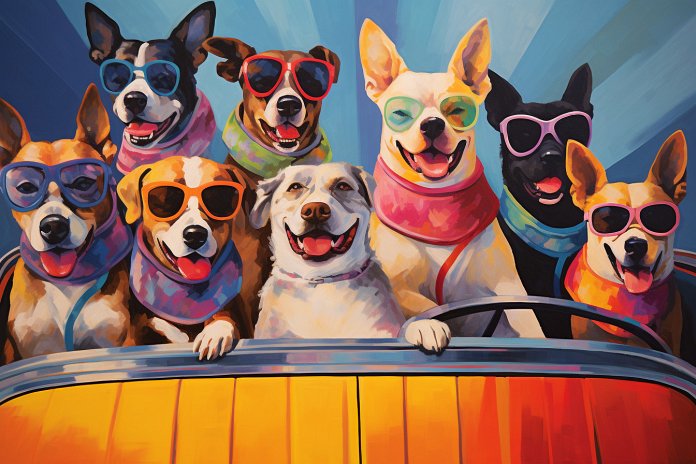
“Go Dog Go” by P.D. Eastman is a beloved book full of fun pictures of dogs driving cars. Dogs driving cars may seem like a fantasy, but with the right training, it has been proven that dogs can actually drive motorized vehicles! Our dogs are smart and have so much personality, and we often see ourselves in them as we share many experiences with our best friends.
Signs a Dog Can Learn to Drive
When you see a picture or video of a dog driving a car, they look confident and happy. They sit up and look ahead, with their mouths open and tongues out, resembling a smile. They appear attentive, calmly taking in the scenery with their open eyes and wiggling noses. These behaviors are signs of a happy dog enjoying a pleasure ride.
To determine if your dog is happy, look for signs of relaxation. Happy dogs blink, have a still yet energetic body posture, and a relaxed tongue hanging out as they take in the smells of their journey. Other signs of a happy dog include relaxed ears, a smiling and relaxed mouth, a loose and wiggling tail, and a wrinkle-free brow. Happy dogs are also playful, have a healthy coat, sleep well, and eat well.
History of Dogs Driving Cars
The New Zealand Society for the Prevention of Cruelty to Animals demonstrated that rescue dogs are smart and capable of learning by training them to drive cars. Three dogs were selected for specialized training, starting with learning a sequence of ten behaviors. They eventually progressed to driving a Mini Cooper. However, these dogs were not trained to drive on the street and the demonstration took place on a racetrack. Other dogs, like Rambo the Golden Retriever, have also gained notoriety for their driving abilities.
The Science of Teaching Dogs to Drive
The driving dogs were trained using a behavior training technique called “chaining,” which is based on classical conditioning and behavior training principles from psychology. Chaining involves linking together specific behaviors that are broken down into steps or components. Trainers use positive reinforcement, consistency, and practice to teach dogs complex behaviors. This technique is commonly used to teach dogs tasks like putting toys away or retrieving birds.
Training Your Dog to Go in the Car
While the future may bring driverless cars, it is still important to work with our dogs to be good passengers in the car. Some dogs may experience motion sickness or fear of cars, so it’s essential to start training them as puppies and gradually expose them to car rides. Avoid feeding them immediately before the ride to prevent upset stomachs and use a crate to keep them safe. Take your dog on rides to different places to create positive associations and plan fun stops for exercise and quality time. Bring necessary supplies and teach your dog to lie down and stay calm if they are not restrained.
“Teach your dog to be a happy and confident passenger on the road.”

Tips & Things to Know
1️⃣ Look for signs of a happy and confident dog: Dogs that are relaxed, have open mouths with tongues hanging out, and show alertness and energy in their body posture and face are likely happy. Pay attention to their body language, such as relaxed ears and loose, wiggling tails, to gauge their happiness.
2️⃣ Understand the science behind teaching dogs complex behaviors: Dogs can learn complex behaviors through a training technique called “chaining,” which involves breaking down the behavior into steps or components and linking them together. Positive reinforcement, consistency, and practice are key to successful training.
3️⃣ Train your dog to be a safe passenger in the car: Whether you’re driving or using a driverless car, it’s important to train your dog to be a good passenger. Start by taking your dog on car rides as a puppy and gradually expose them to different environments. Use a crate to keep them safe and consider planning fun stops for exercise and quality time. Bring necessary supplies for your dog, and if they’re not restrained, teach them to lie down and stay calm during car rides.
Frequently Asked Questions, Answered ✅
1. How can you tell if your dog is happy?
– A happy dog will appear relaxed, blink frequently, have an open and relaxed mouth, and have a loose and wiggling tail.
2. What are some signs of a happy dog?
– Some signs of a happy dog include relaxed ears, a wrinkle-free brow, hopping about and being playful, sleeping well, eating well, and having a healthy coat.
3. How were the dogs trained to drive?
– The dogs were trained using a behavior training technique called “chaining”, which involves breaking down the behavior into steps and linking them together. Positive reinforcement, consistency, and practice were used to train the dogs.
4. Can dogs drive on the street?
– No, the dogs were not trained to drive on the street. The demonstration took place on a racetrack.
5. How can you train your dog to be a good passenger in the car?
– Start by taking your dog on car rides as a puppy and gradually expose them to different places and experiences in the car. Use a crate to keep them safe and bring supplies for their comfort. Teach them to lie down and stay calm if they are not restrained.